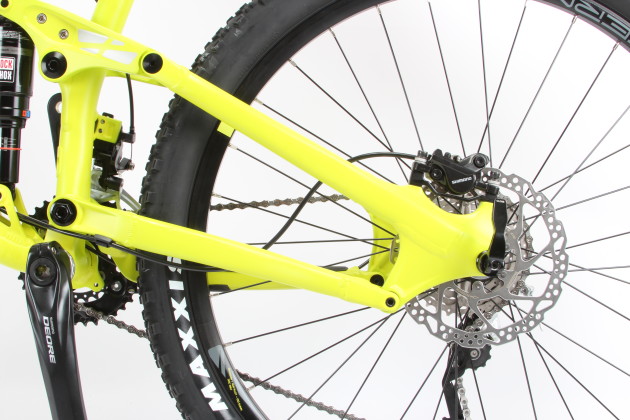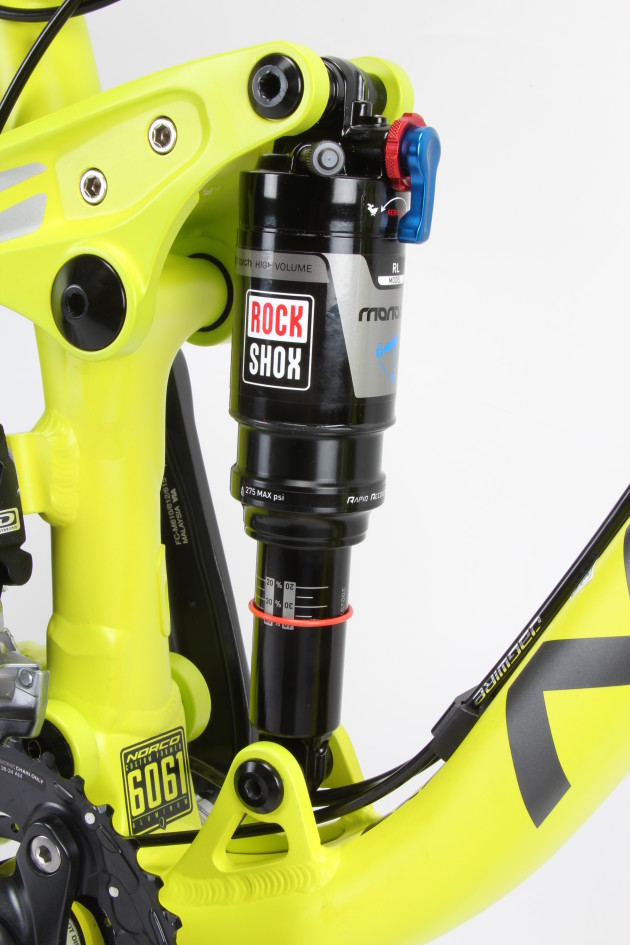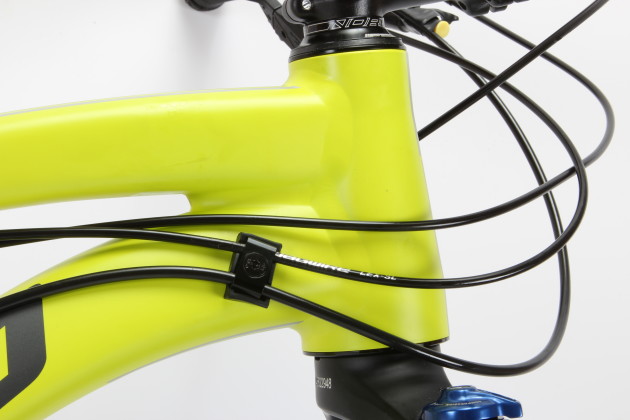Norco Sight A 7.1
The last time I reviewed a Norco Sight was around three years ago; it was just before Norco switched from 26 inch wheels to the current 27.5 ‘standard’. That bike signalled a turning point for Norco; it was one of the very best trail/all-mountain bikes on the market at the time, and the best bike to come from Norco for many years.
Since then the Sight range has steadily evolved and there are currently five bikes in the series. Ranging in price from $2,699 up to $7,299, they all offer 140mm of travel with 27.5 inch wheels. The top three are made from the magic black plastic while the lower two sport full aluminium frames. Our alloy Sight A 7.1 retails for around $3,699 and the large alloy frame hit the scales at 3,310g (with shock) and 14.2kg for the complete bike without pedals.
RockShox controls the travel with a Revelation RL up front and a Monarch RL at the back, while Shimano deals with the stop and go duties; parts are mostly Deore level aside from the clutch equipped XT derailleur and SLX shifters. The bar and stem are basic in-house units, and the WTB Volt saddle sits atop a KS E-Ten dropper post which offers 100mm of travel. It shows a real knowledge of what makes for a good bike when a company specs quality suspension on a well-made frame; it’s the heart of the bike and ultimately this is what determines the ride quality. The components on our Sight were all completely functional, if somewhat weighty, and you can always replace them further down the track as they wear out.

Clever Consolidation
For 2015, the aluminium Sight has seen some simplification to its construction. Gone is the beautifully shaped hourglass head tube, the chainstay clevises are now welded in place instead of forged in one piece, the seat tube gusset is simpler and the rocker is now a bolted together three-piece unit instead of the previous welded version. All of these changes have reduced manufacturing costs at the expense of adding a little weight. It’s not a bad move as the gram counters are likely spring for a carbon model while those shopping alloy bikes are more concerned about value for money and durability.
In an increasingly one-by oriented world, the 2x10 drivetrain may raise a few eyebrows, however it gives enough gear range to cover all manner of riders in all manner of terrain. Adding a 1X specific chainring and removing a derailleur is a simple process should you wish to go down the single ring route. ISCG tabs are present if you want to run a chain guide and the frame will fit a water bottle inside. Mechanics rejoice; the cables use full length housing and are routed almost entirely externally. Maintenance is quick and easy as a result and won’t require any cable fishing. While the stock seatpost uses an external remote cable, there’s provision for a stealth routed dropper post if you’re ever chasing a cleaner look.
With the stock wheels and tyres there’s enough mud room to be called ‘real estate’ in the Sydney housing market, and the construction quality is, as we’ve come to expect from major brands, excellent. The rear axle is now a RockShox Maxle instead of the Syntace X-12 used previously; this one mysteriously came undone on two separate occasions, so I’m not quite sold on the rear Maxle’s security.
From a geometry perspective, I personally struggle to find fault with the Sight. The seat tube is steep to keep your weight centred during seated climbing, and the front centre is rangy enough to keep you from feeling cramped whilst also putting you substantially behind the front wheel. The 67.5 degree head angle is not the slackest out there, nor is the 339mm bottom bracket height the lowest. Instead, these numbers describe a bike that’s made to perform on climbs as well as rough and rutted descents. The Sight, like its shorter-and-longer-legged siblings, uses a relatively short rear centre with chainstays that are definitely at the shorter end of the spectrum. This not only helps to ensure a stiff rear triangle, but makes it easier to toss the bike around and ‘steer from the rear’ on swoopy or twisting trails.
One thing I really like about recent Norco bikes is how they don’t subscribe to a one-size-fits-all mentality. As you go up in frame size, the stem length and chainstay length grows along with the front triangle in order to keep the bike proportions similar for riders of all sizes. They call it ‘Gravity Tune’ and it ensures that the rider’s weight distribution stays relatively constant regardless of frame size. Very cleverly, Norco adjusts the chainstay length by moving the bottom bracket location on the main triangle—this lets them use the same rear end across all sizes to simplify production whilst still offering the size-specific geometry.

Artful Bump Dodger
Like all current Norcos, the Sight uses the ART suspension system—it’s their take on the Horst Link design. Although it’s tweaked a little for each specific bike, it’s found across all platforms and lends a ‘family’ feel to the Norco line-up.
ART uses a very low rear pivot, combined with a slightly higher main pivot, to create a more rearward axle path than many other Horst Link designs. On the various Norco bikes I’ve ridden this translates into great bump absorption, active braking and very efficient seated pedalling. The rearward axle path also creates a lot of ‘chain growth’ as the suspension compresses, and this works to counteract suspension squat when under power. The thing is, ART develops so much anti-squat that if you stand and use poor pedalling technique it actually rises up on the rebound stroke; call it pedal anti-bob if you will. There’s also a correspondingly high level of pedal kickback, which can take a bit to get used to. The unwanted movement doesn’t feel as inefficient as a bike with too little anti-squat, the pedal kickback is tolerable and it still holds traction very well, but they’re the only minor negatives in an otherwise very sorted suspension system.
The Sight A 7.1 isn’t the lightest bike on the trail, although it’s not excessively portly given the price and spec. This means it doesn’t sprint off the line like a lighter bike, but once up to speed it doesn’t feel heavy, just stable. It also feels balanced and it carries its weight low down, so quick direction changes are relatively effortless. It’d be easy to shed some weight when parts start to wear out – especially in the drivetrain – but as it stands the Sight is light enough to not hold you back and it has a solid and reliable feel to justify its weight. The cockpit is well laid out for technical trail riding with a 60mm stem and 760mm wide bars.
The suspension was easy to dial in; I settled on 25-30% sag at the back and 20% for the fork. Even before the new Debonair air sleeve came along (see page 36), the RockShox Monarch rear shock had been steadily earning an excellent reputation, and the Sight helps to further cement that reputation. The suspension tune works with the Monarch’s air spring to provide an excellent balance of small bump sensitivity, pedalling efficiency, mid-stroke support and big hit resistance—it behaves exactly the way a 140mm bike should.
For some years before the Pike reappeared on the scene, the Revelation was the go-to trail fork for RockShox users. Although it puts in a solid performance on the whole, it also demonstrates how far front suspension has come in the last year or two. It’s still smooth and handles bottom-out incidents with control, but it lacks the mid-stroke support of the latest generation forks. When pushed hard it also has some noticeable flex.
It seems I’ve been spoilt by forks with fatter legs; 32mm stanchions were always at their upper limit at 140mm of travel. In any case the fork stands as the weakest link in the suspension package. This is more noticeable because the rest of the bike is laterally stiff, making for a greater contrast in feel from front to back. Again, this was a benchmark fork just a few

years ago, so to say it’s the weak link gives some indication as to the quality of the ART/Monarch combination.
Sight Seeing
The Sight doesn’t hover magically over the trail surface, but rather keeps you completely connected with what’s happening under your tyres. It makes you want to pump features on the trail, seek out little trailside hits and lips and generally get back to the heart of why we ride—for fun.
It’ll happily cope with sketchy descents; it can soak up its fair share of air time and can easily get you into situations where you’ll be questioning your decision to wear an open face helmet. Turn it around and it’s a surprisingly capable, if not lightning fast climber. This is one area where the Sight is different to some other 140mm bikes on the market. Instead of going down the super-slack and super-low route, the slightly more traditional geometry numbers mean it climbs much more easily. Especially on rough ascents, it’s nice not to be constantly smacking the end of your crank arms whilst trying to keep an unruly beast from wandering all over the trail. This more conservative approach might not have the same thrill appeal, but in reality if your bike makes climbing a chore, then you’re only enjoying the ride part of the time. The Sight walks that fine line where it is equal parts climber and descender, and the ideal owner will equally enjoy an uphill challenge as well as a downhill roller coaster.
Admittedly I’m not a huge fan of the rims used on the Sight. The Sun Inferno 25s are a few years old now and they’re lacking in two key areas. Firstly, there’s no flat shoulder on the inner surface, so chances of getting and maintaining a reliable tubeless seal are pretty slim. Speaking of slim, the second area the rims fall short is their paltry 20mm inner width. I know I bang on about the benefits of wide rims, but if you don’t understand why, then I suspect you haven’t spent much time on them. These two factors meant that I had to run tubes for the first time in some years, and also needed an extra 5psi to keep the tyre stable and avoid pinch flats. A tubeless setup with lower pressures gives any bike a huge traction boost, and would be a worthy investment for the Sight down the track. These two issues notwithstanding, the wheels have stayed tight and true—in my experience the Sun rims are generally quite durable too.
The Shimano drivetrain might be low rent, but on the whole it performs very well. Shifting isn’t as crisp as the higher level offerings, but it shifts when you need it to and the clutch rear derailleur helps to keep the chain where it should be. The Deore brakes are likewise budget stoppers, but they carry with them almost all of the feel and performance of their XT stable mates; for budget brakes it’s hard to beat Shimano’s offerings.
The KS dropper post is a budget unit; it lacks the smooth stroke and easy actuation of the best droppers out there, not to mention 25-50mm of travel. Still, if you keep the cable clean and well lubricated, it should hold up just fine and at least you’ve got a dropper post from the get go to help unlock the Sight’s full potential.

If the design brief for the Sight was to create a tough trail bike that can do everything from epic rides to a bit of gravity enduro, and everything in between, then I’d say the team at Norco have just about nailed it. It’s the sort of bike you can take with you when you have no idea what the day’s ride may entail, safe in the knowledge that it will be up to the task.
Money has been saved where it doesn’t matter in order to spend it where it does. The result is a bike with solid all-round performance, but also with huge amounts of upgrade potential. If you’ve got a bigger budget then the carbon models are definitely worth a look, but if I had around $3,500 to spend, the Sight A 7.1 would most certainly be on my short list.
Thumbs Up
Accomplished climber and descender
Well thought out build and component spec
Playful ride
Thumbs Down
Fork can’t quite match the rear suspension performance
Narrow rims that don’t easily convert to tubeless
Specifications
Frame - Hydroformed alloy with ‘Gravity Tune’
Shock - RockShox Monarch RL 140mm travel
Fork - RockShox Revelation RL 140mm travel
Headset - FSA Integrated
Handlebars - Norco Alloy riser 760mm
Stem - Norco 3D forged alloy
Shifters - Shimano SLX
Front Derailleur - Shimano Deore
Rear Derailleur - Shimano XT Shadow Plus
Cassette - Shimano HG62, 11/36 10-speed
Chain - KMC X10
Cranks - Shimano Deore 24/38
Bottom Bracket - Shimano Deore
Pedals - N/A
Brakes - Shimano Deore
Wheels - Sun Inferno 25Tyres - Maxxis Ardent 2.25
Saddle - WTB Volt
Seatpost - KS E-Ten 100mm dropper w/remote
Weight - 14.2kg without pedals (Large frame 3,310g)
Available Sizes - XS, S, M, L (tested) and XL
Price - $3,699
Distributor - Advance Traders 1300 361 686 / www.advancetraders.com.au














